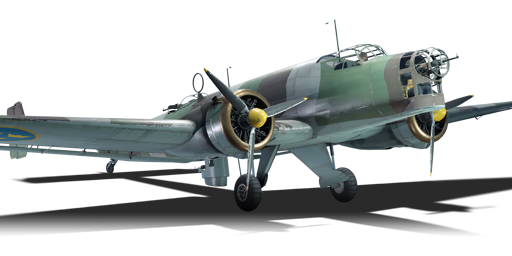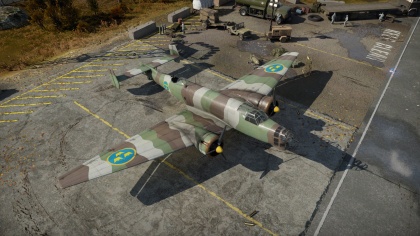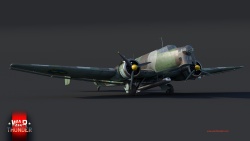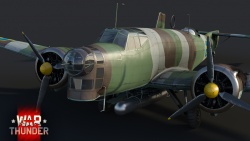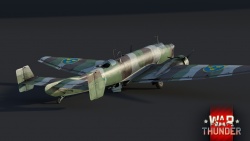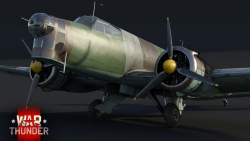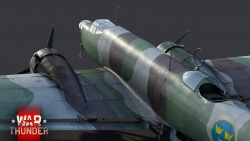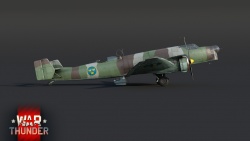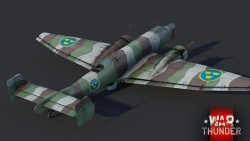Difference between revisions of "B3C"
m (Edits.) |
(Edits) |
||
| Line 2: | Line 2: | ||
== Description == | == Description == | ||
| − | <!--''In the description, the first part should be about the history of and the creation and combat usage of the aircraft, as well as its key features. In the second part, tell the reader about the aircraft in the game. Insert a screenshot of the vehicle, so that if the novice player does not remember the vehicle by name, he will immediately understand what kind of vehicle the article is talking about.''--> | + | <!-- ''In the description, the first part should be about the history of and the creation and combat usage of the aircraft, as well as its key features. In the second part, tell the reader about the aircraft in the game. Insert a screenshot of the vehicle, so that if the novice player does not remember the vehicle by name, he will immediately understand what kind of vehicle the article is talking about.'' --> |
[[File:GarageImage_{{PAGENAME}}.jpg|420px|thumb|left]] | [[File:GarageImage_{{PAGENAME}}.jpg|420px|thumb|left]] | ||
| − | {{ | + | {{Break}} |
The '''{{Specs|name}}''' is a rank {{Specs|rank}} Swedish bomber {{Battle-rating}}. It was introduced in [[Update 1.95 "Northern Wind"]]. | The '''{{Specs|name}}''' is a rank {{Specs|rank}} Swedish bomber {{Battle-rating}}. It was introduced in [[Update 1.95 "Northern Wind"]]. | ||
| − | Originally built by the German aircraft firm Junkers, the {{PAGENAME}} started out as the Ju 86, developed in the mid-1930s alongside rival | + | Originally built by the German aircraft firm Junkers, the {{PAGENAME}} started out as the Ju 86, developed in the mid-1930s alongside rival Heinkel's He 111. Since the Luftwaffe could not officially build bomber aircraft at the time, the main purpose of the aircraft was to be a ten-person airliner which could with minimal effort be converted into a medium bomber. When tested during the Spanish Civil War, it was found that its diesel engines could not hold up against the rigours of combat and were replaced with BMW 123 radial engines which vastly increased its reliability. |
Later in development, the Ju 86K was created for the purpose of exporting this aircraft to foreign nations of which Sweden and Hungary were the first to accept. Sweden started producing their licensed version of the bomber, the B 3 which was outfitted with British Bristol Mercury engines instead of the German BMW radials of which the Mercury engines were later were license-built in Sweden and Poland. | Later in development, the Ju 86K was created for the purpose of exporting this aircraft to foreign nations of which Sweden and Hungary were the first to accept. Sweden started producing their licensed version of the bomber, the B 3 which was outfitted with British Bristol Mercury engines instead of the German BMW radials of which the Mercury engines were later were license-built in Sweden and Poland. | ||
| − | The {{PAGENAME}} though an early war bomber is not without a box of tricks. While relegated to a medium bomber function, options in its suspended armament give it the option to carpet bomb smaller and lighter targets or to bomb heavier protected targets and bases. Externally outfitting an 853 kg torpedo gives the bomber the option to strike fear in fleet captains eyes especially when a crew member announces | + | The {{PAGENAME}} though an early war bomber is not without a box of tricks. While relegated to a medium bomber function, options in its suspended armament give it the option to carpet bomb smaller and lighter targets or to bomb heavier protected targets and bases. Externally outfitting an 853 kg torpedo gives the bomber the option to strike fear in fleet captains eyes especially when a crew member announces "Fish in the water". Though for the most part considered an average bomber when it comes to manoeuvrability, rate of climb and level speed, the {{PAGENAME}} has what it takes to deliver its ordnance to the target and has several critically placed defensive turrets to protect the bomber against any interlopers intent on downing the bomber before it gets to its target. |
== General info == | == General info == | ||
=== Flight performance === | === Flight performance === | ||
| − | <!--''Describe how the aircraft behaves in the air. Speed, manoeuvrability, acceleration and allowable loads - these are the most important characteristics of the vehicle.''--> | + | <!-- ''Describe how the aircraft behaves in the air. Speed, manoeuvrability, acceleration and allowable loads - these are the most important characteristics of the vehicle.'' --> |
| − | |||
The {{PAGENAME}} is an average aircraft when it comes to flight characteristics, nothing really impressive, but nothing which hinders the bombers ability to do its job. Acceleration, rate of climb and level speed are good enough however if caught in a low energy state with nowhere to dive, it will be relatively easy to catch even in the most sluggish of fighters and attackers. The large surface area of the wings enable this aircraft to have a comparatively low stall speed and the dual vertical stabilizers detract from the rudder capabilities of this aircraft compared to aircraft with single vertical stabilizers (see [[B-24D-25-CO|B-24]] vs [[PB4Y-2|PB4Y]] for comparison of vertical stabilizer types). | The {{PAGENAME}} is an average aircraft when it comes to flight characteristics, nothing really impressive, but nothing which hinders the bombers ability to do its job. Acceleration, rate of climb and level speed are good enough however if caught in a low energy state with nowhere to dive, it will be relatively easy to catch even in the most sluggish of fighters and attackers. The large surface area of the wings enable this aircraft to have a comparatively low stall speed and the dual vertical stabilizers detract from the rudder capabilities of this aircraft compared to aircraft with single vertical stabilizers (see [[B-24D-25-CO|B-24]] vs [[PB4Y-2|PB4Y]] for comparison of vertical stabilizer types). | ||
The {{PAGENAME}} was destined for mid to high altitude bombing where it remains safer from a majority of the fighters found flying against it in a match, however dropping to lower altitudes enables even the slowest of biplanes ([[Po-2]] and [[Hs 123 A-1|Hs 123]]) to take pot-shots at the bomber. There will be one option which will require the {{PAGENAME}} to fly low and slow and that will be when setting up for a torpedo run and the bomber will not only be vulnerable to fighters and attackers at the extremely low altitude, they will also be vulnerable to anti-aircraft fire from the ships which should not have much difficulty hitting such a large and slow target. | The {{PAGENAME}} was destined for mid to high altitude bombing where it remains safer from a majority of the fighters found flying against it in a match, however dropping to lower altitudes enables even the slowest of biplanes ([[Po-2]] and [[Hs 123 A-1|Hs 123]]) to take pot-shots at the bomber. There will be one option which will require the {{PAGENAME}} to fly low and slow and that will be when setting up for a torpedo run and the bomber will not only be vulnerable to fighters and attackers at the extremely low altitude, they will also be vulnerable to anti-aircraft fire from the ships which should not have much difficulty hitting such a large and slow target. | ||
| − | {| class="wikitable" style="text-align:center" | + | {| class="wikitable" style="text-align:center" width="70%" |
| − | + | ! rowspan="2" | Characteristics | |
| − | + | ! colspan="2" | Max Speed<br>(km/h at 5,600 m) | |
| − | + | ! rowspan="2" | Max altitude<br>(metres) | |
| − | ! | ||
| − | |||
| − | ! colspan="2" | Max Speed<br>(km/h at | ||
| − | ! rowspan="2" | Max altitude<br>( | ||
! colspan="2" | Turn time<br>(seconds) | ! colspan="2" | Turn time<br>(seconds) | ||
| − | ! colspan="2" | Rate of climb<br>( | + | ! colspan="2" | Rate of climb<br>(metres/second) |
| − | ! rowspan="2" | Take-off run<br>( | + | ! rowspan="2" | Take-off run<br>(metres) |
| − | |||
| − | |||
| − | |||
| − | |||
| − | |||
| − | |||
| − | |||
|- | |- | ||
| − | + | ! AB !! RB !! AB !! RB !! AB !! RB | |
|- | |- | ||
| − | ! | + | ! Stock |
| + | | 372 || 363 || rowspan="2" | {{Specs|ceiling}} || 17.8 || 18.4 || 5.5 || 5.5 || rowspan="2" | 530 | ||
|- | |- | ||
| − | ! | + | ! Upgraded |
| − | + | | 421 || 395 || 16.3 || 17.0 || 10.5 || 7.7 | |
| − | |||
| − | |||
| − | |||
| − | |||
| − | |||
| − | |||
| − | |||
| − | |||
| − | |||
| − | |||
| − | |||
| − | |421||395 | ||
|- | |- | ||
|} | |} | ||
==== Details ==== | ==== Details ==== | ||
| − | {| class="wikitable" style="text-align:center" | + | {| class="wikitable" style="text-align:center" width="50%" |
|- | |- | ||
! colspan="5" | Features | ! colspan="5" | Features | ||
|- | |- | ||
| − | ! Combat flaps | + | ! Combat flaps !! Take-off flaps !! Landing flaps !! Air brakes !! Arrestor gear |
| − | ! Take-off flaps | ||
| − | ! Landing flaps | ||
| − | ! Air brakes | ||
| − | ! Arrestor gear | ||
|- | |- | ||
| − | | | + | | ✓ || ✓ || ✓ || X || X <!-- ✓ --> |
|- | |- | ||
|} | |} | ||
| − | {| class="wikitable" style="text-align:center" | + | {| class="wikitable" style="text-align:center" width="50%" |
|- | |- | ||
| − | ! colspan=" | + | ! colspan="7" | Limits |
|- | |- | ||
| − | ! rowspan="2" | | + | ! rowspan="2" | Wings (km/h) |
| − | ! rowspan="2" | Gear | + | ! rowspan="2" | Gear (km/h) |
| − | ! | + | ! colspan="3" | Flaps (km/h) |
! colspan="2" | Max Static G | ! colspan="2" | Max Static G | ||
|- | |- | ||
| − | ! | + | ! Combat !! Take-off !! Landing !! + !! - |
| − | ! | ||
| − | |||
| − | |||
| − | |||
| − | |||
| − | |||
| − | |||
| − | |||
| − | ! | ||
| − | |||
| − | ! | ||
| − | ! | ||
| − | ! | ||
| − | ! | ||
| − | |||
| − | |||
| − | |||
| − | |||
| − | |||
| − | |||
| − | |||
| − | ! | ||
| − | |||
| − | |||
|- | |- | ||
| − | + | | {{Specs|destruction|body}} || {{Specs|destruction|gear}} || 320 || 280 || 240 || ~5 || ~2 | |
| − | |||
| − | |||
| − | | | ||
| − | | | ||
|- | |- | ||
|} | |} | ||
| Line 124: | Line 69: | ||
== Armaments == | == Armaments == | ||
=== Suspended armament === | === Suspended armament === | ||
| − | <!--''Describe the aircraft's suspended armament: additional cannons under the wings, bombs, rockets and torpedoes. This section is especially important for bombers and attackers. If there is no suspended weaponry remove this subsection.''--> | + | <!-- ''Describe the aircraft's suspended armament: additional cannons under the wings, bombs, rockets and torpedoes. This section is especially important for bombers and attackers. If there is no suspended weaponry remove this subsection.'' --> |
| − | {{main|m/42 (50 kg)|m/40 ( | + | {{main|sb m/42 (50 kg)|mb m/40 (250 kg)|m/41 (450 mm)}} |
| − | * 16 x 50 kg bombs (800 | + | The '''''{{PAGENAME}}''''' can be outfitted with the following ordnance: |
| − | + | * 16 x 50 kg sb m/42 bombs (800 kg total) | |
| − | * 1 x 450 mm m/41 torpedo ( | + | * 1 x 450 mm m/41 torpedo |
| + | * 4 x 250 kg mb m/40 bombs (1,000 kg total) | ||
=== Defensive armament === | === Defensive armament === | ||
| − | <!--''Defensive armament with turret machine guns or cannons, crewed by gunners. Examine the number of gunners and what belts or drums are better to use. If defensive weaponry is not available, remove this subsection.''--> | + | <!-- ''Defensive armament with turret machine guns or cannons, crewed by gunners. Examine the number of gunners and what belts or drums are better to use. If defensive weaponry is not available, remove this subsection.'' --> |
{{main|Ksp m/22-37 R (8 mm)}} | {{main|Ksp m/22-37 R (8 mm)}} | ||
| − | The '''''{{PAGENAME}}''''' is | + | The '''''{{PAGENAME}}''''' is defended by: |
| − | + | * 1 x 8 mm Ksp m/22-37 R machine gun, nose turret (675 rpg) | |
| − | * 1 x 8 mm Ksp m/22-37 R nose turret | + | * 1 x 8 mm Ksp m/22-37 R machine gun, dorsal turret (1,050 rpg) |
| − | * 1 x 8 mm Ksp m/22-37 R dorsal turret | + | * 1 x 8 mm Ksp m/22-37 R machine gun, ventral turret (825 rpg) |
| − | * 1 x 8 mm Ksp m/22-37 R ventral turret | ||
== Usage in battles == | == Usage in battles == | ||
| − | <!--''Describe the tactics of playing in | + | <!-- ''Describe the tactics of playing in the aircraft, the features of using aircraft in a team and advice on tactics. Refrain from creating a "guide" - do not impose a single point of view, but instead, give the reader food for thought. Examine the most dangerous enemies and give recommendations on fighting them. If necessary, note the specifics of the game in different modes (AB, RB, SB).'' --> |
| − | |||
While many aircraft found in War Thunder are considered multi-role capable (fighter, interceptor, attacker and/or bomber), some aircraft sit within just one role but have several subset capabilities within that role. The {{PAGENAME}} is no exception as its sole role in the game is as a medium bomber, however, it is capable of defining its mission depending on the type of suspended ordnance is outfitted. | While many aircraft found in War Thunder are considered multi-role capable (fighter, interceptor, attacker and/or bomber), some aircraft sit within just one role but have several subset capabilities within that role. The {{PAGENAME}} is no exception as its sole role in the game is as a medium bomber, however, it is capable of defining its mission depending on the type of suspended ordnance is outfitted. | ||
| Line 156: | Line 100: | ||
;Torpedo bomber | ;Torpedo bomber | ||
| − | The {{PAGENAME}} can outfit an 853 kg torpedo to the external side of the | + | The {{PAGENAME}} can outfit an 853 kg torpedo to the external side of the aircraft's bomb bays. The big fish can make a big explosion, however, to get the torpedo into the water, the bomber must approach at a low and slow speed heading towards the intended target. Typically, ships don't sit there and just watch the torpedo approach and will begin to open up their anti-aircraft fire. The bomber pilot must maintain calm and precision to drop the torpedo, once released, the bomber must power back up to full speed and vacate the area to avoid further anti-aircraft fire and any potential enemy fighters which may be in the area. |
=== Manual Engine Control === | === Manual Engine Control === | ||
| Line 169: | Line 113: | ||
! rowspan="2" | Turbocharger | ! rowspan="2" | Turbocharger | ||
|- | |- | ||
| − | ! Oil | + | ! Oil !! Water !! Type |
| − | ! Water | ||
| − | ! Type | ||
|- | |- | ||
| − | | | + | | Controllable || Controllable<br>Not auto controlled || Controllable<br>Not auto controlled || Controllable<br>Not auto controlled || Separate || Not controllable<br>1 gear || Not controllable |
|- | |- | ||
|} | |} | ||
| Line 179: | Line 121: | ||
=== Modules === | === Modules === | ||
{| class="wikitable" | {| class="wikitable" | ||
| − | ! | + | ! Tier |
! colspan="2" | Flight performance | ! colspan="2" | Flight performance | ||
| − | ! | + | ! Survivability |
! colspan="2" | Weaponry | ! colspan="2" | Weaponry | ||
|- | |- | ||
| Line 196: | Line 138: | ||
| Airframe | | Airframe | ||
| | | | ||
| − | | | + | | m/41 |
|- | |- | ||
| III | | III | ||
| Line 207: | Line 149: | ||
| IV | | IV | ||
| | | | ||
| − | | | + | | Engine injection |
| Cover | | Cover | ||
| | | | ||
| − | | | + | | m/40 |
|- | |- | ||
|} | |} | ||
=== Pros and cons === | === Pros and cons === | ||
| − | <!--''Summarise and briefly evaluate the vehicle in terms of its characteristics and combat effectiveness. Mark its pros and cons in the bulleted list. Try not to use more than 6 points for each of the characteristics. Avoid using categorical definitions such as "bad", "good" and the like - use substitutions with softer forms such as "inadequate" and "effective".''--> | + | <!-- ''Summarise and briefly evaluate the vehicle in terms of its characteristics and combat effectiveness. Mark its pros and cons in the bulleted list. Try not to use more than 6 points for each of the characteristics. Avoid using categorical definitions such as "bad", "good" and the like - use substitutions with softer forms such as "inadequate" and "effective".'' --> |
| + | |||
'''Pros:''' | '''Pros:''' | ||
| − | |||
* Wide range of payload options | * Wide range of payload options | ||
* Effective defensive turrets | * Effective defensive turrets | ||
'''Cons:''' | '''Cons:''' | ||
| − | |||
* Average flight characteristics | * Average flight characteristics | ||
* Large wing profile, an easy target for attacking fighters | * Large wing profile, an easy target for attacking fighters | ||
| Line 228: | Line 169: | ||
== History == | == History == | ||
| − | <!--''Describe the history of the creation and combat usage of the aircraft in more detail than in the introduction. If the historical reference turns out to be too long, take it to a separate article, taking a link to the article about the vehicle and adding a block "/ History" (example: <nowiki>https://wiki.warthunder.com/(Vehicle-name)/History</nowiki>) and add a link to it here using the <code>main</code> template. Be sure to reference text and sources by using <code><nowiki><ref></nowiki></code>, as well as adding them at the end of the article. This section may also include the vehicle's dev blog entry (if applicable) and the in-game encyclopedia description (under <code><nowiki>=== In-game description ===</nowiki></code>, also if applicable).''--> | + | <!-- ''Describe the history of the creation and combat usage of the aircraft in more detail than in the introduction. If the historical reference turns out to be too long, take it to a separate article, taking a link to the article about the vehicle and adding a block "/History" (example: <nowiki>https://wiki.warthunder.com/(Vehicle-name)/History</nowiki>) and add a link to it here using the <code>main</code> template. Be sure to reference text and sources by using <code><nowiki><ref></ref></nowiki></code>, as well as adding them at the end of the article with <code><nowiki><references /></nowiki></code>. This section may also include the vehicle's dev blog entry (if applicable) and the in-game encyclopedia description (under <code><nowiki>=== In-game description ===</nowiki></code>, also if applicable).'' --> |
| + | The SAAB B3C began its life in the mid-1930s in Germany as the Junkers Ju 86. The purpose of this aircraft was to operate first as a high-speed passenger airliner but also function as a medium bomber with minimal conversion. Conversion from airliner required the removal of ten passenger seats and replaced with four bomb cells which carried each bomb in an upright position. Fuel tanks for the bomber version were located in the fuselage while the airliner moved them to the wings. Originally this bomber was outfitted with Junkers Jumo 205 diesel engines, their drawback was their weight, however, they were more fuel-efficient than standard petrol engines. Unfortunately during the Spanish Civil War, it was determined that the Ju 86 under-performed compared to the He 111, mainly because the diesel engines could not handle the rough treatment endured during combat situations. With this knowledge, the Ju 86 was converted to the BMW 132 radial engines which drastically improved the reliability of this bomber. | ||
| − | + | The Junkers model Ju 86K was the export version of the Ju 86 which allowed Sweden's aircraft manufacture SAAB to license build these medium bombers and designated them as the B 3. Instead of utilising BMW132 engines, SAAB opted to go with the Bristol Mercury XIX radial engines which had an output of 905 horsepower. The Swedes maintained their B 3 bombers throughout the war and continued to use them for another thirteen years with several being converted to maritime patrol and signal intelligence (SIGINT) aerial platforms to keep apprised of Soviet and Eastern Europe activity. | |
| − | |||
| − | The Junkers model Ju 86K was the export version of the Ju 86 which allowed | ||
== Media == | == Media == | ||
| − | <!--''Excellent additions to the article would be video guides, screenshots from the game, and photos.''--> | + | <!-- ''Excellent additions to the article would be video guides, screenshots from the game, and photos.'' --> |
| − | |||
;Images | ;Images | ||
<div><ul> | <div><ul> | ||
| Line 249: | Line 188: | ||
== See also == | == See also == | ||
| − | <!--''Links to the articles on the War Thunder Wiki that you think will be useful for the reader, for example:'' | + | <!-- ''Links to the articles on the War Thunder Wiki that you think will be useful for the reader, for example:'' |
* ''reference to the series of the aircraft;'' | * ''reference to the series of the aircraft;'' | ||
| − | * ''links to approximate analogues of other nations and research trees.''--> | + | * ''links to approximate analogues of other nations and research trees.'' --> |
| − | |||
;Aircraft of comparable role, configuration and era | ;Aircraft of comparable role, configuration and era | ||
| − | |||
* Heinkel [[He 111 H-6|He 111]] | * Heinkel [[He 111 H-6|He 111]] | ||
* Dornier [[Do 17 (Family)|Do 17]] | * Dornier [[Do 17 (Family)|Do 17]] | ||
| Line 260: | Line 197: | ||
== External links == | == External links == | ||
| − | <!--''Paste links to sources and external resources, such as:'' | + | <!-- ''Paste links to sources and external resources, such as:'' |
* ''topic on the official game forum;'' | * ''topic on the official game forum;'' | ||
* ''encyclopedia page on the aircraft;'' | * ''encyclopedia page on the aircraft;'' | ||
| − | * ''other literature.''--> | + | * ''other literature.'' --> |
| − | + | * [[wt:en/news/6492-development-saab-b3c-bomber-to-start-from-en|[Devblog] SAAB B3C: Bomber to Start From]] | |
| − | * [ | ||
{{AirManufacturer Saab}} | {{AirManufacturer Saab}} | ||
| − | {{ | + | {{Sweden bombers}} |
| − | |||
| − | |||
Revision as of 20:20, 29 March 2020
Contents
Description
The B3C is a rank I Swedish bomber
with a battle rating of 1.0 (AB) and 1.3 (RB/SB). It was introduced in Update 1.95 "Northern Wind".
Originally built by the German aircraft firm Junkers, the B3C started out as the Ju 86, developed in the mid-1930s alongside rival Heinkel's He 111. Since the Luftwaffe could not officially build bomber aircraft at the time, the main purpose of the aircraft was to be a ten-person airliner which could with minimal effort be converted into a medium bomber. When tested during the Spanish Civil War, it was found that its diesel engines could not hold up against the rigours of combat and were replaced with BMW 123 radial engines which vastly increased its reliability.
Later in development, the Ju 86K was created for the purpose of exporting this aircraft to foreign nations of which Sweden and Hungary were the first to accept. Sweden started producing their licensed version of the bomber, the B 3 which was outfitted with British Bristol Mercury engines instead of the German BMW radials of which the Mercury engines were later were license-built in Sweden and Poland.
The B3C though an early war bomber is not without a box of tricks. While relegated to a medium bomber function, options in its suspended armament give it the option to carpet bomb smaller and lighter targets or to bomb heavier protected targets and bases. Externally outfitting an 853 kg torpedo gives the bomber the option to strike fear in fleet captains eyes especially when a crew member announces "Fish in the water". Though for the most part considered an average bomber when it comes to manoeuvrability, rate of climb and level speed, the B3C has what it takes to deliver its ordnance to the target and has several critically placed defensive turrets to protect the bomber against any interlopers intent on downing the bomber before it gets to its target.
General info
Flight performance
The B3C is an average aircraft when it comes to flight characteristics, nothing really impressive, but nothing which hinders the bombers ability to do its job. Acceleration, rate of climb and level speed are good enough however if caught in a low energy state with nowhere to dive, it will be relatively easy to catch even in the most sluggish of fighters and attackers. The large surface area of the wings enable this aircraft to have a comparatively low stall speed and the dual vertical stabilizers detract from the rudder capabilities of this aircraft compared to aircraft with single vertical stabilizers (see B-24 vs PB4Y for comparison of vertical stabilizer types).
The B3C was destined for mid to high altitude bombing where it remains safer from a majority of the fighters found flying against it in a match, however dropping to lower altitudes enables even the slowest of biplanes (Po-2 and Hs 123) to take pot-shots at the bomber. There will be one option which will require the B3C to fly low and slow and that will be when setting up for a torpedo run and the bomber will not only be vulnerable to fighters and attackers at the extremely low altitude, they will also be vulnerable to anti-aircraft fire from the ships which should not have much difficulty hitting such a large and slow target.
| Characteristics | Max Speed (km/h at 5,600 m) |
Max altitude (metres) |
Turn time (seconds) |
Rate of climb (metres/second) |
Take-off run (metres) | |||
|---|---|---|---|---|---|---|---|---|
| AB | RB | AB | RB | AB | RB | |||
| Stock | 372 | 363 | 8000 | 17.8 | 18.4 | 5.5 | 5.5 | 530 |
| Upgraded | 421 | 395 | 16.3 | 17.0 | 10.5 | 7.7 | ||
Details
| Features | ||||
|---|---|---|---|---|
| Combat flaps | Take-off flaps | Landing flaps | Air brakes | Arrestor gear |
| ✓ | ✓ | ✓ | X | X |
| Limits | ||||||
|---|---|---|---|---|---|---|
| Wings (km/h) | Gear (km/h) | Flaps (km/h) | Max Static G | |||
| Combat | Take-off | Landing | + | - | ||
| 430 | 350 | 320 | 280 | 240 | ~5 | ~2 |
Survivability and armour
Examine the survivability of the aircraft. Note how vulnerable the structure is and how secure the pilot is, whether the fuel tanks are armoured, etc. Describe the armour, if there is any, and also mention the vulnerability of other critical aircraft systems.
Armaments
Suspended armament
The B3C can be outfitted with the following ordnance:
- 16 x 50 kg sb m/42 bombs (800 kg total)
- 1 x 450 mm m/41 torpedo
- 4 x 250 kg mb m/40 bombs (1,000 kg total)
Defensive armament
The B3C is defended by:
- 1 x 8 mm Ksp m/22-37 R machine gun, nose turret (675 rpg)
- 1 x 8 mm Ksp m/22-37 R machine gun, dorsal turret (1,050 rpg)
- 1 x 8 mm Ksp m/22-37 R machine gun, ventral turret (825 rpg)
Usage in battles
While many aircraft found in War Thunder are considered multi-role capable (fighter, interceptor, attacker and/or bomber), some aircraft sit within just one role but have several subset capabilities within that role. The B3C is no exception as its sole role in the game is as a medium bomber, however, it is capable of defining its mission depending on the type of suspended ordnance is outfitted.
- Small target bomber
As an early rank bomber, the B3C has access to many of the smaller weight bombs found in the game. Loading up with the 50 kg bombs allow the bomber to take out many of the lightly protect vehicles found on the map to include trucks, light tanks, anti-aircraft artillery, light pill-boxes/bunkers and aircraft parked on a runway. Vehicles travelling in columns make for an especially tempting target as when lined up properly, the B3C can come in at a lower altitude and drop individual bombs per target being more judicious with the suspended ordnance, especially in realistic and simulator battles where reloads require heading back to base. Heavy pillboxes, medium and heavy tanks along with bases should be avoided as these smaller bombs will be less effective against them.
- Large/protected target bomber
When it comes to attacking a base or targets such as reinforced pillboxes, large ships, medium and heavy tanks, the 250 kg and 600 kg bombs will come in handy. With a harder punch, these bombs will make short work of the vehicles which the 50 kg bombs will realistically just bounce off of. Base bombing will be more effective specifically if the B3C is flying at 4,000 m and above where it is less likely to run into enemy fighters and if it does, the defensive turrets can make it that much more difficult for them to get sights on.
- Torpedo bomber
The B3C can outfit an 853 kg torpedo to the external side of the aircraft's bomb bays. The big fish can make a big explosion, however, to get the torpedo into the water, the bomber must approach at a low and slow speed heading towards the intended target. Typically, ships don't sit there and just watch the torpedo approach and will begin to open up their anti-aircraft fire. The bomber pilot must maintain calm and precision to drop the torpedo, once released, the bomber must power back up to full speed and vacate the area to avoid further anti-aircraft fire and any potential enemy fighters which may be in the area.
Manual Engine Control
| MEC elements | ||||||
|---|---|---|---|---|---|---|
| Mixer | Pitch | Radiator | Supercharger | Turbocharger | ||
| Oil | Water | Type | ||||
| Controllable | Controllable Not auto controlled |
Controllable Not auto controlled |
Controllable Not auto controlled |
Separate | Not controllable 1 gear |
Not controllable |
Modules
| Tier | Flight performance | Survivability | Weaponry | ||
|---|---|---|---|---|---|
| I | Fuselage repair | Radiator | Turret 8 mm | ||
| II | Compressor | Airframe | m/41 | ||
| III | Wings repair | Engine | New 8 mm MGs (turret) | ||
| IV | Engine injection | Cover | m/40 | ||
Pros and cons
Pros:
- Wide range of payload options
- Effective defensive turrets
Cons:
- Average flight characteristics
- Large wing profile, an easy target for attacking fighters
- Significant defensive blind spots from the side, above and below
History
The SAAB B3C began its life in the mid-1930s in Germany as the Junkers Ju 86. The purpose of this aircraft was to operate first as a high-speed passenger airliner but also function as a medium bomber with minimal conversion. Conversion from airliner required the removal of ten passenger seats and replaced with four bomb cells which carried each bomb in an upright position. Fuel tanks for the bomber version were located in the fuselage while the airliner moved them to the wings. Originally this bomber was outfitted with Junkers Jumo 205 diesel engines, their drawback was their weight, however, they were more fuel-efficient than standard petrol engines. Unfortunately during the Spanish Civil War, it was determined that the Ju 86 under-performed compared to the He 111, mainly because the diesel engines could not handle the rough treatment endured during combat situations. With this knowledge, the Ju 86 was converted to the BMW 132 radial engines which drastically improved the reliability of this bomber.
The Junkers model Ju 86K was the export version of the Ju 86 which allowed Sweden's aircraft manufacture SAAB to license build these medium bombers and designated them as the B 3. Instead of utilising BMW132 engines, SAAB opted to go with the Bristol Mercury XIX radial engines which had an output of 905 horsepower. The Swedes maintained their B 3 bombers throughout the war and continued to use them for another thirteen years with several being converted to maritime patrol and signal intelligence (SIGINT) aerial platforms to keep apprised of Soviet and Eastern Europe activity.
Media
- Images
See also
- Aircraft of comparable role, configuration and era
External links
| Swedish Aeroplane Company Ltd. (SAAB) | |
|---|---|
| Pre-SAAB: ASJA | J6B |
| Fighters | J21A-1 · J21A-2 · A21A-3 |
| Jet fighters | A21RB · J21RA · J29A · A29B · J29D · J29F · J32B · J35A · J35D · JA37C · JA37D · JAS39A |
| Jet attackers | A32A · A32A Röd Adam · AJ37 · AJS37 · SAAB-105G · SK60B |
| Bombers | B17A · B17B · S17BS |
| Dive-bombers | B3C · B18A · B18B · T18B · T18B (57) |
| Export | SAAB-105OE · Saab J35XS · JAS39C · ◔JAS39EBS HU C |
| Sweden bombers | |
|---|---|
| B3 | B3C |
| B17 | B17A · B17B · S17BS |
| SAAB 18 | B18A · B18B · T18B · T18B (57) |
| T 2 | T 2 |
| Finland | ▄Ar 196 A-5 · ▄Ju 88 A-4 |


